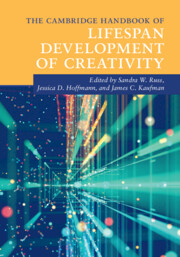Book contents
- The Cambridge Handbook of Lifespan Development of Creativity
- The Cambridge Handbook of Lifespan Development of Creativity
- Copyright page
- Dedication
- Contents
- Figures
- Tables
- Contributors
- Acknowledgments
- Introduction
- Part I Core Concepts of Lifespan Creativity Development
- Part II The Development of Creativity
- 5 Are Preschoolers Creative?
- 6 Development of Creativity in School-Age Children
- 7 The Development and Enhancement of Adolescent Creativity
- 8 The Intertwined Development of Identity and Creativity
- 9 Creative Development in Children from a Measurement Perspective
- 10 Creativity in Adulthood
- 11 The Many Faces of Creativity in Old Age
- Part III Modes of Enhancement
- Part IV Environments and Contexts
- Part V Special Populations
- Index
- References
5 - Are Preschoolers Creative?
A Review of the Literature
from Part II - The Development of Creativity
Published online by Cambridge University Press: 19 November 2021
- The Cambridge Handbook of Lifespan Development of Creativity
- The Cambridge Handbook of Lifespan Development of Creativity
- Copyright page
- Dedication
- Contents
- Figures
- Tables
- Contributors
- Acknowledgments
- Introduction
- Part I Core Concepts of Lifespan Creativity Development
- Part II The Development of Creativity
- 5 Are Preschoolers Creative?
- 6 Development of Creativity in School-Age Children
- 7 The Development and Enhancement of Adolescent Creativity
- 8 The Intertwined Development of Identity and Creativity
- 9 Creative Development in Children from a Measurement Perspective
- 10 Creativity in Adulthood
- 11 The Many Faces of Creativity in Old Age
- Part III Modes of Enhancement
- Part IV Environments and Contexts
- Part V Special Populations
- Index
- References
Summary
What can research tell us about creativity in 3- to 5-year-old children? This chapter reviews the last 50 years of research to address this question. Several themes emerge. First, creativity has been notoriously difficult to define and measure, and is often studied in the context of children’s play and temperament. Second, the methods for studying creativity have been limited – largely relying on divergent-thinking measures. Third, there is interest in interventions that aim to foster creativity in young children. While the field has amassed a lot of data, strong studies are hard to find. Here, we boldly suggest that it is time to move beyond the traditional literature. Looking at more narrowly construed fields like curiosity, exploration, and innovation can offer a toehold into a better understanding of this broad field and holds the promise of helping researchers develop a more coherent model of how creativity plays out in the lives of young children.
- Type
- Chapter
- Information
- The Cambridge Handbook of Lifespan Development of Creativity , pp. 101 - 125Publisher: Cambridge University PressPrint publication year: 2021



